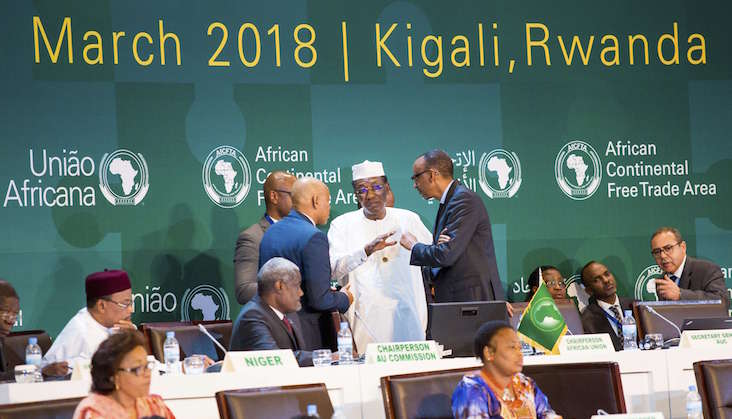African governments are finally following through on their promises to build a free trade area after decades of talk.
One year on from the historic signature of the framework deal for the African Continental Free Trade Agreement (AfCFTA) in Kigali, the continent’s nascent free trade deal is on the agenda for business and political leaders at the Africa CEO Forum on 25-26 March, also taking place in the Rwanda capital.
- On 21 March 2018, 49 governments signed the framework deal for the AfCFTA at the African Union summit. The 80-page-long document would create the world’s largest free trade area, with 1.2 billion inhabitants and a GDP of about $3trn.
- Article 23 requires that 22 countries ratify the AfCFTA deal in order for it to take effect. To date 21 countries have done so.
- Albert Muchanga, the AU commissioner for trade and industry says that the free trade area could come into effect by July.
Niger’s President Mahamadou Issoufou, who is leading the AU’s drive to bring the project to fruition after almost three decades of debate, says: “These 84,000km of borders between our 55 countries are 84,000km of obstacles to trade between us.”
What are the AfCFTA’s main goals?
- Give companies accesses to markets that are larger than colonially imposed national boundaries.
- Help create the 20m to 30m jobs needed each year to accommodate the waves of young people entering the labour market.
- Boost intra-African trade from 15% to at least 25% within the next ten years, in order to protect the continent from external shocks like changes in commodity prices or exchange rates.
What AfCFTA requires
- Massive cuts to customs and duties, which are a major source of government revenue.
- The simplification of bureaucratic procedures.
- Huge investment in road, railroad, air, digital and financial infrastructure.
- The strengthening of regional economic communities, like the East African Community, which serve as the building-blocks of continental integration.
Despite the willingness of the 49 governments who signed up to the principle of the AfCFTA, there are many obstacles in the way of a pan-African free trade bloc. One concerns the geographical, political, economic and social heterogeneity of the continent. Another is the shift of sovereignty that is necessary to make the AfCFTA a success. Governments are also worried about the loss of an important revenue stream in the form of trade tariffs. Meanwhile, companies are worried about the impact on the less competitive sectors.
- Aruna Bineswaree Bolaky, an economist at the United Nations Conference on Trade and Development, says: “In order to benefit from the removal of customs duties, companies will have to be subject to rules of origin. That means that a product will have to be manufactured using mostly African inputs up to a certain level and using a procedure that has not yet been negotiated. For example, if Kenya wants its T-shirts to be exempt from customs duties, it will have to use Egyptian rather than Chinese cotton.”
In terms of countries, the big players are the most reluctant. Nigeria does not currently want to join the AfCFTA. Its labour unions and local business owners worry that small and medium-sized companies may not be not strong enough to face the competition from huge multinationals taking advantage of the trade deal. A continental investment code that would have rules for foreign investors, could address these concerns.
- Benoît Chervalier, founder of the One2five Advisory based in Paris, says: “Nigeria [but also Egypt and South Africa] are wary of the emphasis on consensus in the AfCFTA, and in the end this could give a sort of veto to all its members. It does not want to be at the mercy of small countries.”
Meanwhile, the smaller and poorer countries have their own worries. They predict that they will be inundated with products from their bigger and richer neighbours. They also will be hardest hit by the drop in customs revenue.
- Jaime De Melo, an emeritus professor at the University of Geneva, says accommodating measures are needed: “To get over these risks, the AfCFTA must accept exceptions on cutting customs duties for the poorest and most vulnerable countries. Like in the European Union, where the underdeveloped countries benefit from financial help from the community, the AfCFTA will need a compensation mechanism for poorer countries.”
What comes next?
After the AfCFTA comes into force, there are likely to be a new round of discussions about creating institutions that foster dialogue, monitor compliance and provide technical assistance. Its early success will depend greatly on how its bodies can arbitrate disputes and smooth over continental growing-pains.
This article first appeared in Jeune Afrique.
Understand Africa’s tomorrow… today
We believe that Africa is poorly represented, and badly under-estimated. Beyond the vast opportunity manifest in African markets, we highlight people who make a difference; leaders turning the tide, youth driving change, and an indefatigable business community. That is what we believe will change the continent, and that is what we report on. With hard-hitting investigations, innovative analysis and deep dives into countries and sectors, The Africa Report delivers the insight you need.
View subscription options

